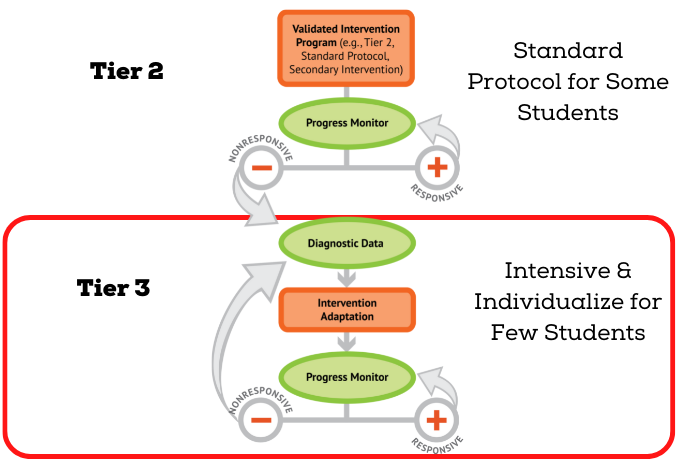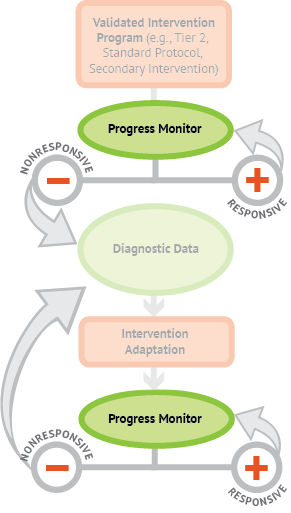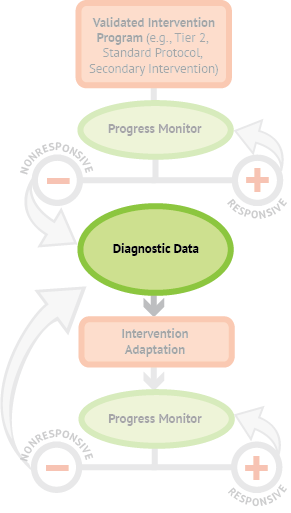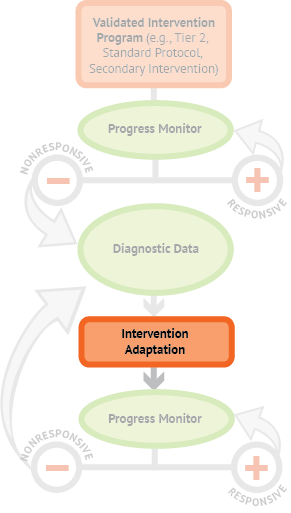Tier 3 Overview: Academic - Social Emotional - Behavioral
Intensive intervention or Tier 3 is the most intense level in a multi-tiered system of supports (MTSS). At Tier 3, a student-centered team process is utilized to support individual students with intensive needs. The quality and fidelity of Tier 1 and Tier 2 sets the foundation for successful implementation of intensive intervention. Schools/teams focusing on Tier 3 often find it necessary to improve their Tier 1 and 2 systems as part of continual school improvement in order to better meet the needs of their most complex learners (National Center on Intensive Intervention 2022).

Research suggests that intensive intervention will be needed for about 5 - 10% of students, including students with disabilities, to be successful in a multi-tiered system of supports (Fuchs et al., 2008; NCII, 2013). The process we use in Rhode Island
for intensifying is called Data-Based Individualization (DBI). DBI is driven by data, characterized by increased intensity and individualization, and considers both the academic and behavioral strengths and needs of the student (National Center
on Intensive Intervention 2013). These students may include:
-
Students who have not responded to an otherwise effective evidence-based Tier 2 intervention delivered with fidelity.
-
Students that screening data indicate have an urgent intensity of need (e.g., at the secondary level, the size of the gap between student performance level and that of peers may indicate that the student needs an immediate, intensive intervention).
-
Students with IEPs who are not making adequate progress in meeting IEP goals.
DBI requires the integration of validated interventions and assessments across the five steps (Peterson, Danielson, & Fuchs, 2019) shown in the graphic above. Click each corresponding tab below to learn more.

Progress monitoring should not be confused with less formal monitoring of progress used in typical school instruction. Teachers use informal, often unstandardized, assessment approaches to make immediate, real-time instruction changes, but this differs significantly from progress monitoring within a MTSS. Progress monitoring in a MTSS refers to standardized, valid and reliable tools (i.e., General Outcome Measures). Prior to delivering the validated intervention platform, progress monitoring expectations should be outlined: the progress monitoring tool, student goal, and frequency of data collection and review. During delivery of the validated and adapted intervention, educators should collect and graph frequent progress monitoring data according to the plan. After sufficient data are collected (e.g., weekly for six to nine data points), they are graphed and evaluated against the student’s instructional or behavioral goal to determine whether the student is making sufficient progress.

After sufficient data has been collected and graphed, progress is evaluated against the student’s instructional or behavioral goal to determine whether the student is making sufficient progress. If the trendline is below the goal or aimline, then the response is not (yet) adequate and we move to the next step in the intensification process. In most cases, students with severe and persistent learning needs, including students with disabilities, will require several rounds of adaptation before progress is sufficient. If at any time the team suspects a disability, a special education evaluation referral should be initiated. The data collected through intensification can be used in the referral and evaluation processes.
When progress in response to an intervention implemented with fidelity is inadequate, teams need to dig deeper. In this step of DBI, teams engage in a diagnostic process to develop a hypothesis about the potential cause(s) of the student’s academic and/or behavioral difficulties. This hypothesis drives the team’s decisions about how best to support the student and adapt the intervention. This process starts with informal approaches, such as error analysis of frequent progress monitoring data or intervention program mastery data; review of class assessments and work samples; or administration of standardized tools available through publishers. In the behavior domain, diagnostic assessment may occur through less formal function-based analysis (i.e., FACTS) or more formal functional behavioral assessment (i.e., FBA). Additionally, teams should consider student voice in the development of intensification plans, especially at the secondary level. In Rhode Island’s model, since academic and behavioral needs don’t exist separate from one another, we conceptualize a diagnostic process that hypothesizes if the needs is an “isn’t doing” (i.e., relationship, engagement and motivation), a “trouble doing” (i.e., difficulty performing the skill automatically and generalizing it to new situations), or a “can’t do” (i.e., skill deficit/instructional mismatch possibly indicating need for a different intervention)

After completing a diagnostic process and hypothesizing the nature of a student's struggle, the team moves on to plan adaptations to better meet these individual needs. The plan often identifies a clear focus (i.e., addressing student
barriers to intervention fidelity such as absences, addressing a ‘isn’t doing’, a ‘trouble doing’, or a ‘can’t do’). The intensification plan also defines who is responsible for which part of the plan and by when. Finally,
the team sets the date when they will come together after having implemented the intensification plan to see if it worked. Recall that students with the most complex needs, including students with disabilities, may require several
rounds of adaptation before progress is sufficient. The process repeats until we figure it out - together. Go team!

A student or group of students may require intensive intervention in one skill area (e.g., math problem solving) in addition to core math instruction at Tier 1 and a Tier 2 intervention in another targeted area (e.g., math computational fluency). We know all learners learn differently and intensive intervention is just one part of the full continuum of supports that make up a multi-tiered system of supports (National Center on Intensive Intervention 2013).
Learn More About Tier 3
If you're interested in improving your school's implementation of Tier 3, be sure to check out BRIDGE-RI's strand of courses devoted to this topic. Beginning with the Tier 3 Overview course, you'll learn more about the practices, data, and systems needed to support an effective Tier 3. See all current Tier 3 course offerings. Please note that you must have an account with BRIDGE-RI to enroll in courses. Sign up today - it's free and easy!
